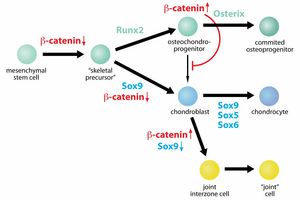Regulation of cell Lineage Differentiation

The various cell types of the appendicular skeleton, chondrocytes, osteoblasts and the cells contributing to the future synovial joints are of mesenchymal origin. Over the past years we demonstrated that the canonical Wnt/β-catenin pathway plays very important roles for the differentiation of the different skeletal lineages in the mouse (see Figure 1). In the absence of functional canonical β-catenin signaling, osteoblast precursors, the osteochondro-progenitor cells, differentiate into chondrocytes (Hill et al., 2005). Furthermore, we have shown that the canonical Wnt/β-catenin pathway is required to suppress the chondrogenic potential of cells in the joint interzone (Spaeter et al., 2006). This suggests that differentiation along the chondrocyte lineage may be the default and that increased levels of β-catenin are required to enable the differentiation along the other two lineages.

